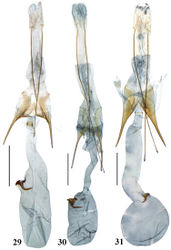Scrobipalpa zhengi
| Notice: | This page is derived from the original publication listed below, whose author(s) should always be credited. Further contributors may edit and improve the content of this page and, consequently, need to be credited as well (see page history). Any assessment of factual correctness requires a careful review of the original article as well as of subsequent contributions.
If you are uncertain whether your planned contribution is correct or not, we suggest that you use the associated discussion page instead of editing the page directly. This page should be cited as follows (rationale):
Citation formats to copy and paste
BibTeX: @article{Li2019ZooKeys840, RIS/ Endnote: TY - JOUR Wikipedia/ Citizendium: <ref name="Li2019ZooKeys840">{{Citation See also the citation download page at the journal. |
Ordo: Lepidoptera
Familia: Gelechiidae
Genus: Scrobipalpa
Name
Scrobipalpa zhengi Li & Bidzilya, 2019 sp. n. – Wikispecies link – ZooBank link – Pensoft Profile
- Scrobipalpa cryptica Povolný, 1996, Bidzilya and Li 2010[1]: 3. Misidentification.
Type material
CHINA: Holotype ♂, Suyukou, Mt. Helan, Ningxia Hui Autonomous Region, 2000 m, 10.viii.2005, coll. Xinpu Wang et al. (gen. slide no. 125/08) (NKU). Paratypes: 1 ♀, same data as for holotype (gen. slide no. 34/14, O Bidzilya); 1 ♂, Xiazigou, Yaba, Mt. Helan, Alashan Left Banner, Inner Mongolia, 1793 m, 30.vii.2010, coll. Hongxia Liu and Zhiwei Zhang (gen. slide no. LJ17310).
Diagnosis
The new species can hardly be separated externally from S.cinerea Povolný, 1996. The male genitalia remotely resemble those of S.atriplicella (Fischer von Röslerstamm, 1841), but can be distinguished by the shorter uncus, the tapered sacculus, the broader vincular process and the broader saccus. The female genitalia are similar to those of S.sattleri Lvovsky & Piskunov, 1989, but the subgenital plates are densely covered with microtrichia and the signum is smaller.
Description
Adult (Fig. 13). Wingspan 14.5–15.0 mm. Head, thorax and tegulae covered with brown, black-tipped scales, frons white, labial palpus grey mottled with brown, segment 2 with diffuse black rings on outer surface, segment 3 with distinct broad black basal and medial rings, upper and inner surface of segment 2 dirty-white, scape brown, other antennal segments brown with light grey basal rings; forewing covered with grey black tipped scales, three diffuse black spots at base, black triangular spot on 1/5 of costal margin, paired black dot in fold on 1/4 length, black spot edged with ochreous on 1/4 length in middle, two others at 2/3 in middle width, diffuse strongly angulated light grey subapical fascia at 3/4 length, cilia greyish brown tipped; hindwing and cilia grey.
Male genitalia (Fig. 23). Uncus slightly longer than broad, subrectangular, posterolateral corners rounded; gnathos short, slender, weakly curved; tegumen narrow, anteromedial emargination extending to 1/3 length, broadly rounded; valva narrow, of even width, weakly curved, apex rounded, extending to the top of uncus; sacculus narrow, straight, ca. 1/5 length of valva, gradually tapered, apex pointed, inner margin with small hump before top; vincular process as long as sacculus, apex with outwardly curved tip; posterior margin of vinculum with deep v-shaped medial emargination; saccus broad at base, distal half narrow, of equal width, extending beyond the top of pedunculus; phallus straight, apical arm short, apex weakly pointed, caecum slightly broader and slightly longer than half length of phallus.
Female genitalia (Fig. 31). Papilla analis elongate, ovate, sparsely covered with hairs; apophyses posteriores five times longer than segment VIII; sternite VIII longer than broad, subrectangular, posterior margin weakly emarginated, postgenital plates ca. 1/3 width of sternite VIII, densely covered with microtrichia except for narrow area under posterior margin, gradually narrowing anteriorly, with gradual transition to apophyses anteriores, ventromedial depression prolonged, subrectangular, weakly narrowed in middle, densely covered with microtrichia, broadly divided anteromedially nearly to 1/2 length into edged lobes which not are extending beyond anterior margin of sternite VIII; apophyses anteriores as long as sternite VIII, straight, broad at base, gradually tapered; ductus bursae broad, of even width except for posterior portion that is narrower, with distinct transition to rounded corpus bursae; basal plate of signum small, distal hook short, weakly curved, narrow, acute.
Biology
Host plant unknown. The adult was collected in early August at an altitude of 2000 m.
Distribution
China (Inner Mongolia, Ningxia).
Etymology
The species is named in honour of Professor Zhemin Zheng (Xi’an, China) for his outstanding contributions to systematic entomology.
Original Description
- Li, H; Bidzilya, O; 2019: New species and new records of the genus Scrobipalpa Janse (Lepidoptera, Gelechiidae) from China ZooKeys, 840: 101-131. doi
Images
|
Other References
- ↑ Bidzilya O, Li H (2010) The genus Scrobipalpa Janse (Lepidoptera, Gelechiidae) in China, with description of 13 new species.Zootaxa2513: 1–26. https://doi.org/10.11646/zootaxa.2513.1.1


